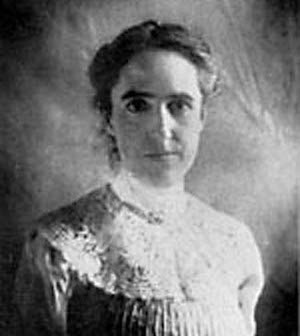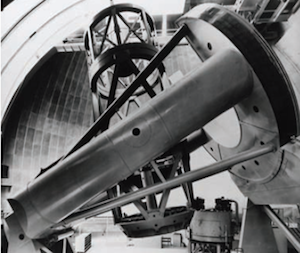"Yardsticks" in Neighbor Galaxy Double Universe's Size
Walter Baade, an astronomer at the California Institute of Technology, says the Universe is twice as large as we thought. He has used the giant 200-inch reflecting at Mount Palomar to measure the scale of the Universe.

Image credit: Public Domain via Wikimedia Commons
Henrietta Swan Leavitt
Baade's discovery hasn't come from simply reading mile markers in space. To properly determine the distance to stars and the scale of the Universe, he first had to discover that Nature has created more than one kind of measuring tool ("yardstick"). Until a few years ago, there was just one measuring tool known to astronomers, and it was being used incorrectly. Oddly enough, it took the wartime black-outs in Los Angeles to begin setting things straight. (These blackouts were periods of time at night when people had to turn off all lights or make certain all lights were blocked by heavy curtains to minimize the danger of night-time bombings or spying raids. During these times, light pollution was greatly reduced, and astronomers could better study light from space.)
That first "yardstick" was discovered around the turn of the century. It is a type of pulsating, variable star called a Cepheid. Cepheid stars become very bright and then very dim (or pulsate) over a period of several days to several weeks. Henrietta S. Leavitt of the Harvard Observatory was studying the Magellanic Clouds, which are small galaxies outside of the Milky Way. Here she noticed that brighter Cepheids pulsed slower than dimmer Cepheids. This was interesting, because all the stars in the Magellanic Clouds are basically the same distance from Earth, so it suggested that the rate at which those Cepheids were pulsing was a clue to their real brightness (or luminosity). By comparing how bright the stars really are, to how bright they look (their apparent magnitude), their distance could be calculated.
For example, if an astronomer sees a Cepheid in our own Milky Way galaxy that appears dim, he can observe how fast it pulsates to determine if the star is close or far away. He can use Miss Leavitt's brightness/pulsation relationship to do this. If the star pulsates rapidly, then the star really is dim and not far away. If the star pulsates slowly, then the star is actually bright, and only looks dim because it is very far away.
After Miss Leavitt completed her work, astronomer Solon Bailey discovered that the same relationship seemed to be true for Cepheids found in dense star clusters in our own Galaxy. Next, astronomer Harlow Shapley standardized the "yardstick," so he could measure the distance of fast-period and slow-period Cepheids both inside and outside these dense globular clusters in the Milky Way.
"Thus a period-luminosity relation was established which covered the whole range of the Cepheid variation and which was accepted as the period-luminosity relation for the next 30 years," recalled Baade in a speech at a recent award ceremony of the Astronomical Society of the Pacific.
Unfortunately, Shapley's yardstick had flaws. In 1931, Doctor Edwin Hubble began studying the starlight from globular clusters in Andromeda, a galaxy near the Milky Way. For some reason those clusters were burning more dimly than similar clusters here in the Milky Way. This mismatch meant either the globular clusters in Andromeda are basically different than those in our own Milky Way, or Andromeda must be further than originally calculated.

Image credit: Mt. Wilson-Palomar Observatories photo, courtesy AIP Emilio Segre Visual Archives, Physics Today Collection
The telescope that confirmed the scale of the cosmos: Mount Palomar's 200-inch Hale Telescope was completed in 1949.
The solution to this mismatch came during the wartime blackouts of 1943 in California. Doctor Baade took advantage of the darkened skies and the power of the 100-inch Hooker telescope at the Mount Wilson Observatory near Los Angeles to re-examine Andromeda's globular clusters.
Using special red-sensitive photographic plates Dr. Baade discovered two populations of stars:
- redder, fainter "Type II" stars in globular clusters near Andromeda's center and in its outlying halo (the same arrangement as in the Milky Way)
- bluer, brighter "Type I" variable stars located in open clusters in Andromeda's disk (outer spiral arms).
Dr. Baade realized that there must be two populations of Cepheids – Type I Cepheids more common in the disk of a galaxy and Type II Cepheids more common in the globular clusters.
According to Dr. Baade, Shapley did not realize Cepheids in globular clusters have a different period-luminosity relationship compared to Cepheids in open clusters. He made a major error when he treated them the same on his yard-stick. This would be similar to treating a yardstick (Type I Cepheid) exactly the same as a meter stick (Type II Cepheid). They are very different measuring tools.
At Mount Palomar, Baade and his computer assistant Henrietta Swope recently confirmed that both types of Cepheids are very different types of stars. After recalibrating his measuring sticks, Dr. Baade startled his peers in 1952 at the Rome meeting of the International Astronomical Union by announcing that Andromeda was not 800,000 light-years away, as Hubble thought, but 1.8 million light-years distant. Likewise, with the two measuring sticks sorted out, the Universe we knew in 1929 to be one billion light-years wide has now doubled to two billion light-years across. •



